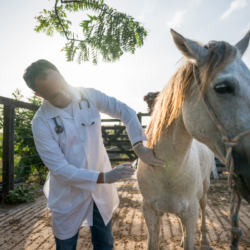The term “Piro-Like syndrome” is used to describe a range of symptoms caused by vector-borne diseases in equidae. External animals such as ticks or rodents carry these diseases. They are not transmitted directly from one horse to another. The differential diagnosis of this syndrome includes five diseases: piroplasmosis, anaplasmosis, Lyme disease, leptospirosis and Equine Infectious Anemia. The clinical picture associated with the syndrome includes hyperthermia of unknown origin and non-specific symptoms such as anorexia, lethargy or loss of condition, associated with anaemia.
Only laboratory blood tests can establish a precise diagnosis and define the most appropriate treatment. The Epona Panel Piro-Like tests are new-generation molecular tests that detect and discriminate the pathogen simply, reliably and quickly. These tests enable affected animals to be isolated and treated before the first clinical signs appear.
Piroplasmosis
Piroplasmosis is a parasitic disease affecting equidae, caused by the protozoa Theileria equi and Babesia caballi. Non-contagious, it is transmitted by ticks of the Dermacentor, Rhipicephalus and Hyalomma genera, as well as by transplacental transmission. Most infected horses become latent carriers.
After entering the body, the piroplasmas multiply in the red blood cells, triggering an inflammatory response that is responsible for the clinical signs. In the acute phase, symptoms include anaemia, hyperthermia (> 40°), jaundice, haematuria, oedema of the limbs, and cardiac or renal complications. Colic, nervous symptoms, enteritis and ataxia may also be observed. Without prompt treatment, the disease can be fatal.
In the chronic phase, clinical signs are less apparent and fluctuate, including exertional fatigue and moderate chronic anaemia. In the case of Theileria, a chronic latent phase may persist for a long time, with the parasites localised in the spleen, liver and bone marrow. If the immune defences fail, the parasite may reappear in the blood.
Diagnosis of piroplasmosis is based on blood counts, biochemistry, smears, PCR and serology. The main treatment is Imidocarb (Carbesia). To prevent the disease, it is advisable to treat pastures and horses against ticks, and to remove ticks promptly.
Anaplasmosis
Anaplasmosis is an infectious, non-contagious disease caused by the bacterium Anaplasma phagocytophilum, transmitted by ticks of the genus Ixodes. These ticks live for around three years and are found throughout France, except on the Mediterranean coast and at altitudes above 1,500 metres.
The bacteria multiply in the white blood cells and then in the red blood cells, weakening the horse’s immune defences and triggering an inflammatory response. Symptoms appear between 8 and 12 days after inoculation by the tick and include hyperthermia, depression, anorexia, ataxia, distal oedema of the limbs, petechiae, tachycardia and polypnoea. Recovery generally takes between 3 and 16 days with appropriate care, or sometimes occurs spontaneously, although rare cases of death have been reported.
Diagnosis is based on blood tests: NF, biochemistry, Frottis (showing leucopenia, thrombocytopenia, anaemia, and inclusion bodies in neutrophils), PCR (to detect active infections), and serology (to detect antibodies).
The main treatment is oxytetracycline. As a preventive measure, it is advisable to treat pastures and horses against ticks. Although similar to piroplasmosis, anaplasmosis is distinguished by its bacterial transmission. Symptoms include fever, depression and anorexia, with asymptomatic infections sometimes occurring. There is no vaccine for equidae. Preventive measures include treatment of pastures and prompt removal of ticks after they have been bitten. Various acaricides can be used, although their application to horses is not strongly encouraged.
Lyme disease
Borreliosis, or Lyme disease, is an infectious, non-contagious disease caused by the bacterium Borrelia burgdorferi. Transmitted mainly by ticks of the genus Ixodes, it can also be carried by fleas, mosquitoes and horseflies, making it a zoonosis.
After the bite, the bacteria remain in the dermis for several days, sometimes causing visible erythema in humans. Bacteremia is generally short-lived and transient before spreading to various organs. Symptoms may appear several months after the initial infection and include a systemic form with mild fever, lethargy, anorexia, chronic emaciation, stiffness, intermittent lameness, synovial distension, uveitis, abortion and behavioural disorders. Localised clinical forms may be neurological, cutaneous or include uveitis. Many infections remain asymptomatic.
Diagnosis is based on a variety of techniques. PCR is generally negative on blood, but can be performed on skin, vitreous, cerebrospinal fluid and/or nerve tissue biopsies. Serology detects antibodies 3 to 6 weeks after infection, with a peak at around three months. These antibodies persist from 1.5 months to over two years, with no decrease after treatment.
The main treatment is oxytetracycline. Prevention includes treating pastures and horses against ticks, as well as promptly removing ticks after they have been bitten. Although similar to piroplasmosis, borreliosis is distinguished by its bacterial transmission and its various symptoms, including fever, depression and anorexia, with asymptomatic infections sometimes occurring. There is currently no vaccine against borreliosis in equidae. Preventive measures recommend the elimination of tick-friendly habitats and the careful use of various acaricides.
Leptospirosis
Leptospirosis is an infectious disease caused by the bacterium Leptospira, comprising several serogroups such as Interrogans and Ictérohaemorrhagiae, the latter being more pathogenic. These bacteria can survive for long periods in water and soil, particularly at temperatures around 20°C. Rodents are the main hosts of Leptospira, contaminating water and soil with their urine. This zoonosis also affects dogs, which can be vaccinated against it.
Infection occurs through ingestion of contaminated water or food, or through the skin. Leptospires travel through the bloodstream and can be found in various organs such as the liver, kidneys, spleen, CNS, genital tract, placenta and eyes. Infected horses can excrete the bacteria in urine, milk, semen and aborted foetuses several weeks to several months after infection.
Symptoms of the systemic form include fever, depression, anorexia, jaundice, haemoglobinuria and petechiae. Numerous localised clinical forms are possible, including renal, hepatic, pulmonary, uveitis and abortion. The disease is often subclinical, with a benign course.
Diagnosis is based on PCR, which can be performed on blood, urine, vitreous, aborted babies, placenta and cerebrospinal fluid. Serology detects antibodies 15 days after infection, with persistence from 6 months to over 2 years. A titre greater than 800 with suggestive symptoms indicates an active infection.
Treatment is based on the administration of penicillin or oxytetracycline for 7 days. Prevention includes rodent control, drainage of wet meadows and cleaning up stagnant water.
Equine infectious anaemia (EIA)
Equine infectious anaemia (EIA ) is a serious, often latent, viral disease caused by a virus of the Retrovirus family. Infected horses remain carriers for life, even if they have no symptoms.
Symptoms, triggered by stress, include high fevers and anaemia. Transmission occurs through the bite of a haematophagous insect or the use of contaminated equipment. A contaminated horse remains a carrier of the virus for the rest of its life.
There is no treatment for EIA. Prevention is based on regular screening of equidae and isolation of positive horses. Insect control measures and the use of single-use equipment for injections can also help prevent the spread of the disease.
In France, EIA is a government-regulated disease classified as a category 1 health hazard. Screening for EIA is compulsory in a number of cases:
- for stallions used in artificial insemination
- for export to third countries
- at sales and purchase visits. AIE is a redhibitory defect, with a redhibition period of 30 days.
All equine species are susceptible to EIA, but the disease is not transmissible to humans. There are different clinical forms of the disease, ranging from superacute to asymptomatic. The asymptomatic form is the most common in horses in France. Donkeys are mostly healthy carriers.
Diagnosis of the disease can only be made with certainty using an official analysis technique. This involves testing for antibodies in the blood (Coggins test). Approved laboratories in France carry out this analysis. Only government-approved laboratories can carry out this analysis.





